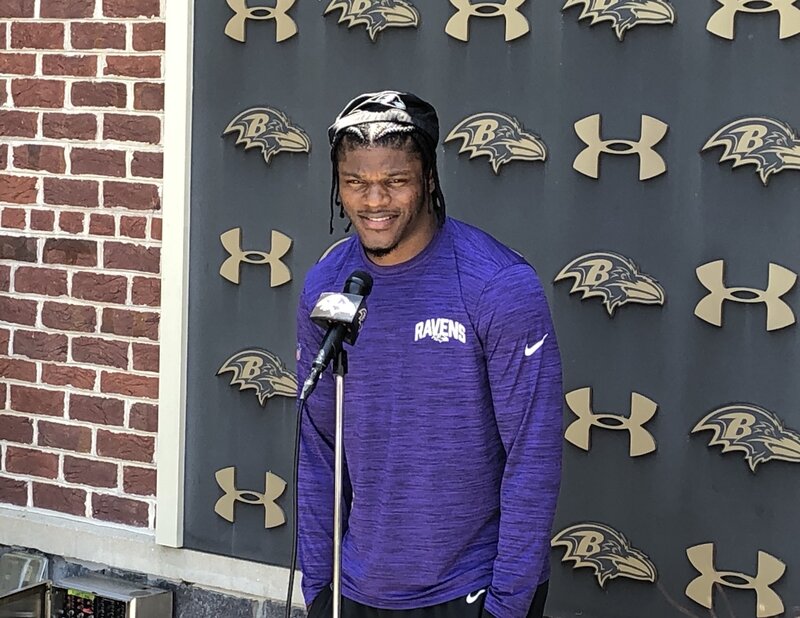First-year general manager Eric DeCosta followed through after stating more than once over the last calendar year that the Ravens needed to take more swings at the wide receiver position in the NFL draft.
Having lost five notable members of his top-ranked defense this offseason, DeCosta could have made the safe play by loading up on defensive players early while waiting until Day 3 to pluck a wide receiver or two off the board. It was the playbook often used by predecessor Ozzie Newsome — winner of two Super Bowls, mind you — to an almost maddening degree in recent years and for much of the history of the franchise.
DeCosta was quick to state it wasn’t deliberate, but the Ravens drafted two wide receivers — Oklahoma’s Marquise Brown and Notre Dame’s Miles Boykin — in the first three rounds, equaling the total selected in the opening three rounds by Newsome in the previous 11 drafts combined. Even if it was “just kind of how the board fell” as DeCosta put it, the Ravens were the first team to draft a wide receiver in the first round — one regarded as the fastest in the draft — and then traded up nine spots in the third round to take a 6-foot-4, 220-pound wideout who ran a surprising 4.42-second 40-yard dash.
The Ravens weren’t just drafting any wide receivers to aid in second-year quarterback Lamar Jackson’s development, but there was a specific trait in mind, which became even more evident when DeCosta selected Oklahoma State running back Justice Hill with his first pick on Saturday.
“One of the main common denominators is speed. It makes it tough on a defense,” said DeCosta, citing the best opposing offenses he’s watched from the press box in recent seasons. “As good as our defense has been, it’s a challenge for a team to face speed when you have multiple guys on the field at the same time who can run and make explosive plays. It’s challenging. We got a chance to see what Lamar can do this past year, and I think our collective vision for the offense is to add more guys like that to make it really challenging on the defense.”
These picks do carry substantial risk as the history of wide receivers taken with the final 10 picks of the first round in recent years hasn’t been pretty. Brown’s potential speaks for itself if you’ve watched any of his video game-like highlight videos, but we’re still talking about a 5-foot-9, 170-pound receiver currently recovering from a Lisfranc injury. Veteran cornerback Jimmy Smith has acknowledged that same injury still giving him problems years later, but the difference is how much more reliant an undersized receiver like Brown will be on that unique speed.
Boykin could carry more upside than any wide receiver the Ravens have ever drafted — admittedly a low bar — but he registered only 18 receptions before his senior season at Notre Dame, which is often a predictor of underwhelming production at the next level. Still, his physical traits and good catch rate last year were too enticing for the Ravens to overlook.
History says Brown and Boykin are more likely to both be busts than both be draft successes, but having too great a risk-averse mindset leaves one standing on the sideline wondering why the Ravens never get better at the position. Without a top-five pick — and even that isn’t always foolproof — you have to roll the dice from time to time to find dynamic play-making ability, especially if you want to maximize your investment in a first-round quarterback. And that needed to be a priority in this draft.
“Those two guys have [play-making ability] many times over,” head coach John Harbaugh said. “You have a big, fast guy (Boykin), who’s a powerful guy, who can catch and get upfield with the ball with his stride length and his stiff arm, and he goes up and makes catches. He’s a developing player. He’s kind of a younger, developing player. He’s only really had one year in the offense.
“Then, you have the smaller, faster guy (Brown) with quick feet that can make people miss in a short area, in a tight area. He can catch and run in crossing routes. But the bottom line is, these are two really fast guys that make plays, and that’s what we were looking for.”
Offensive coordinator Greg Roman couldn’t have been happier this weekend as he now has some speedy toys to use on the perimeter to complement his dynamic running game and collection of tight ends to make plays over the middle. In addition to what Brown and Boykin bring, Hill posted the fastest 40 time of all running backs at this year’s scouting combine, making him an intriguing change-of-pace option to starter Mark Ingram and the physical Gus Edwards in the backfield.
No, the draft didn’t bring some seismic shift in philosophy as the offense’s foundation will continue to be the ground game, but DeCosta’s early picks made clear the Ravens’ intentions to expand their approach beyond simply running the ball 50 times per game and minimizing Jackson’s passing opportunities. Baltimore addressed its need to get faster, something that had become more apparent watching some of the best offenses in the league in recent years.
There’s no guarantee this will all work to perfection as so much will hinge on Jackson’s development as a passer, but credit DeCosta and the Ravens for taking some risks to improve his chances of succeeding. If nothing else, it should be fun watching opponents try to combat an unconventional offensive attack.
“The idea of adding speed with Lamar is just an exciting thing to think about teams having to defend,” director of college scouting Joe Hortiz said. “I know Greg is excited about it and John is excited about it. It’s a chance to really put fear into opposing defenses. I think it really gets you excited.”










